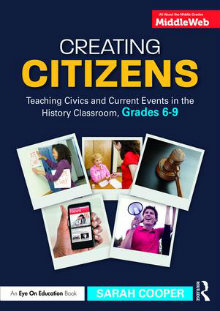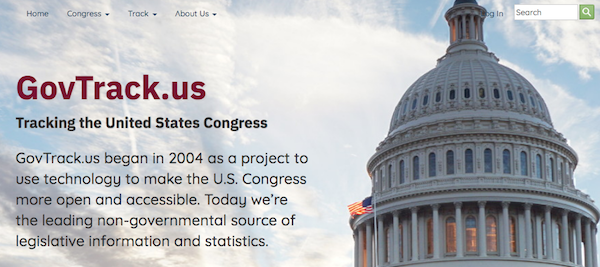What Students Can Learn by Writing to Politicians
A MiddleWeb Blog
 Writing a letter to a politician is about as “civic” an assignment as we can do within our classroom walls, and it feels especially relevant in our polarized political climate.
Writing a letter to a politician is about as “civic” an assignment as we can do within our classroom walls, and it feels especially relevant in our polarized political climate.
For the first two years that my U.S. history and civics students wrote these letters, though, I didn’t quite hit the mark with my directions.
The first year, the eighth graders did the letters just before summer break, and so they didn’t get to share with the class any responses they received. Even though we linked the assignment to Abraham Lincoln’s speeches from our Civil War unit and Harper Lee’s prose style from To Kill a Mockingbird, it felt somehow anticlimactic.
The second time around went better, as the culmination of our fall Constitution unit, but we still didn’t get back as many letters back as I’d hoped, maybe 10 percent. Students often wrote not to their own representatives but to other politicians who had sponsored interesting bills, which I think lowered the response rate.
This year, I vowed that the letters would be as targeted as possible to ensure that we received the most responses, and the drafts perked up for a number of reasons. Here’s what I’ve learned over three years about helping students produce the meatiest missives:
1. Go interdisciplinary with the topics.
At our school, eighth graders do a Community Impact Project, in which they design individual projects that help the community and then measure their impact. This year, at the suggestion of the science teacher who supervises the projects, I required students to write their letters about a related topic. The connection could be precise or more general, as stated in the directions:
For instance, if you are doing a sports clinic for kids at the local Boys & Girls Club, you could choose a directly related topic by writing about something you think the Boys & Girls Club (or organizations like it) needs from the government.
Alternately, you could choose a broadly related topic by doing research on, for example, the availability of sports fields in various communities, or funding for women’s versus men’s sports programs.
Students posted the letters, along with any response from the politician, on their Community Impact Project boards at our school’s annual STEAM & Service Fair. As a result, the assignment felt authentic in two ways: first, the politician’s office would read the letter, and, second, parents and peers would see the letters on display.
2. Base letters on a bill, if possible.
This year, before doing any writing or outlining, students took most of a 77-minute block period to explore bills and articles related to their topic. Although I didn’t require them to find a specific bill, because I wasn’t sure everyone would be able to, I strongly encouraged them to give it a try. Helpful sites included Govtrack.us for national bills and the California legislature site for state proposals.
During this research period, I was thrilled and surprised to see students, even those who are not the strongest readers, trying to understand what a bill was saying so that they could address its points in their letters. They also became keenly interested in where the bill was in the process: whether it had already passed, was stuck in committee, or lay somewhere in-between.
If a bill had already passed, I encouraged these middle schoolers to write to their representative urging more such bills to be passed in the future. And all of a sudden, the bill “dying in committee” in the iconic Schoolhouse Rock video seemed a little less funny to them than it had the week before!
Next year I would build in time for students to discuss with a partner, mid-period, what they had researched and see if their partner could help them make sense of it.
3. Find the best people to whom to address the letters.
Usually the “best person” ended up being one of five people:
• One of the two U.S. senators for our state
• The U.S. House representative for the student’s district
• The California State Assembly member for the student’s district
• The California State Senator for the student’s district
If students found another politician who did not represent their district or state, they could write to that person, but I cautioned that the likelihood of a response was not as strong. They could also choose to write to anyone else – in the U.S. Cabinet, Supreme Court, or elsewhere – who might be interested in their topic.
Some students took the job of finding the right person especially seriously. For example, Julia wrote to the governor of California encouraging him to appoint a poet laureate who would promote poetry to children. Sienna chose the California secretary of state because she wanted to increase voter registration, and Evan and Kazuma selected the state superintendent of public instruction to contact about school supplies and Walk to School Day.
4. Relate the project explicitly to how Congress and state legislatures work.
One unexpected bonus of urging students to find a bill, as well as to discover their state and national representatives, was that they had to become very clear on who and what they were researching.

At times students thought they were looking at the page of their California assembly member when, in fact, they were looking at their U.S. House member. Correcting this misconception helped them understand the roughly parallel structures of the U.S. Congress and the state legislatures. And I was thrilled to come up with a metaphor on the spot one day – that there are 50 “baby Congresses,” one for each U.S. state!
5. Give detailed advice and models for writing the letters.
This site with tips for writing letters to Congress is practical and realistic. There are also many sample letters to politicians online, such as this brief three-paragraph version from the American Library Association or this longer letter from the National Coalition for the Homeless.
In addition, here are the guidelines and calendar I created for the entire project, which gave a week’s worth of time to research and write in class. Feel free to adapt this for your own use if you find it helpful.
6. Proofread the drafts thoroughly so that students can be proud of their work.
Last year I made the mistake of reading only the final drafts of students’ letters – and only after we had mailed off a copy of the final draft to the politician. When I then marked errors on the copy I was grading, some students understandably felt embarrassed that the other copy was already in the mail. Oops!
This year I built in time for me to proofread and give suggestions for rough drafts on Google Docs, including during one class period while my students were watching Episode 3 of the fantastic Constitution USA series by Peter Sagal. As always, when I make comments on rough drafts, I feel much more confident that I am helping students improve their writing and thinking skills.
Another option, if grading all of these drafts seems prohibitive, is to create a “committee” of students who love to copy edit (there are always a few!) and ask them to do a quick once-over of the letters while their classmates are doing something else. Students did do peer response, as we usually do, but the quality of feedback varied enough that I wanted to make sure I saw every draft.
Having a Voice in the World
In an anonymous online midyear survey that I often ask students to fill out in December, so that I can course correct as needed for second semester, many students mentioned that they enjoyed writing this letter to a politician.
One eighth grader connected the assignment to our Constitution unit, especially the Bill of Rights: “I enjoyed writing a letter to a politician because it really exercised our rights (stated in the First Amendment) as a U.S. citizen.”
Another said: “I liked the politician letter a lot. It taught me how to write a formal letter and made me feel like I had a voice in the world.”
Enough said! This project, after three years of tweaks, is finally a keeper.
____________________________________________________
 For ideas on folding current events and civics into your classes throughout the school year, try Sarah Cooper’s book, Creating Citizens: Teaching Civics and Current Events in the History Classroom, Grades 6–9, a Routledge/MiddleWeb publication. MiddleWeb readers receive a 20% discount from Routledge with the code MWEB1.
For ideas on folding current events and civics into your classes throughout the school year, try Sarah Cooper’s book, Creating Citizens: Teaching Civics and Current Events in the History Classroom, Grades 6–9, a Routledge/MiddleWeb publication. MiddleWeb readers receive a 20% discount from Routledge with the code MWEB1.


































